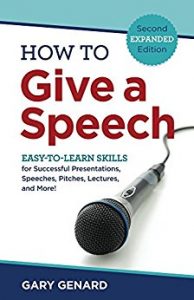Body language rules: 12 ways to be a more powerful speaker
You’re probably thinking: What on earth has this got to do with technical analysis? Well, in my efforts to make this blog relevant/interesting/amusing to STA members and their friends, I trawl media sources for stories, articles and all sorts. To this end I subscribe and/or am subjected to all sorts of email. So guess what – this week I have done nothing but deal with accepting or rejecting terms for GDPR rules which come into force Friday.
To do so I must remind myself of what the source does, and I found this unexpected file. Brought to me by TradePub.com, it was one in a series by the GenardMethod.com – tips about public speaking, which I’m sure many of us could use a little help with.
First, they suggest, choose to stand rather than sit, giving your body space to express itself and your audience plenty to look at. Then make sure you ground yourself, feet squarely placed under your armpits – sitting or standing. Then keep arms at your side, hanging naturally, unless you want to make a point when you can raise them above waist level. Use open body positions, avoiding crossing arms or locking hands.
The fifth point is to sit up straight (and listen), as my teacher used to say. Avoid slouching when sitting and learn a little forward as it makes one look interested in the proceedings. Keep hand gestures to a minimum but use them effectively to make a point by making them well defined. If standing, don’t wander across the stage for the sake of it, but do take a couple of steps when starting a new point.
Points 8 and 9 are linked, exhorting the speaker to ‘love your audience more than your manuscript/PowerPoint screen’. Your presentation is a performance, not a read through; persuade them. Here I would also add: have a dry run through at home and time yourself; overrunning ahead of the next speaker is exceedingly rude. Also, don’t hang on to the podium for dear life, but feel free to stand aside and let people see your hands. Then move back to centre stage when you are about to move on to the next point.
When dealing with questions, welcome them. I favour telling my audience whether you will only take them after the talk, or whether they can ask along the way – the risk with this is that you’ll get bogged down or lose your pace. Avoid finger-pointing. Finally, don’t hold a writing instrument unless you are going to use it.
Gary Genard has a book out: How to Give a Speech, in its second expanded edition.

Tags: posture, presentations, Public speaking, Technical Analysis Courses
The views and opinions expressed on the STA’s blog do not necessarily represent those of the Society of Technical Analysts (the “STA”), or of any officer, director or member of the STA. The STA makes no representations as to the accuracy, completeness, or reliability of any information on the blog or found by following any link on blog, and none of the STA, STA Administrative Services or any current or past executive board members are liable for any errors, omissions, or delays in this information or any losses, injuries, or damages arising from its display or use. None of the information on the STA’s blog constitutes investment advice.
Latest Posts
- Avoid Revenge Trading: The Key to Long-Term Trading Success March 31, 2025
- Mastering Relative Strength Portfolios: Key Takeaways from the March STA Meeting March 12, 2025
- Stay Disciplined, Stay Profitable February 26, 2025
- Understanding Price Gaps in Trending February 19, 2025
- Key Takeaways from a Fireside Chat with Perry Kaufman February 12, 2025




















Latest Comments